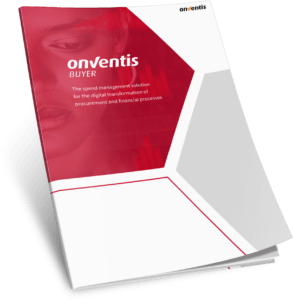Optimization Of Indirect Procurement: Definition, Challenges, Solutions
In a company, income and expenditure are continuously contrasted. In addition to sales, customer acquisition, and maximizing sales, purchasing also plays a decisive role as a central instrument for managing profits.
However, procurement is not just procurement: it can be subdivided into individual areas that deal with purchasing different resources. A distinction is made between direct and indirect procurement, which complement each other and ensure that operations run smoothly.

Optimization Of Indirect Procurement: Definition, Challenges, Solutions
In a company, income and expenditure are continuously contrasted. In addition to sales, customer acquisition, and maximizing sales, purchasing also plays a decisive role as a central instrument for managing profits.
However, procurement is not just procurement: it can be subdivided into individual areas that deal with purchasing different resources. A distinction is made between direct and indirect procurement, which complement each other and ensure that operations run smoothly.
Direct Procurementvs. Indirect Procurement: What is the Difference?
Direct procurement refers to procuring resources that are required to manufacture the company’s product directly or to provide the services offered by the company. If these goods are not purchased, it affects the production process, as they flow directly into the end product and form the core business in purchasing.
Indirect procurement focuses on the purchasing of resources that are required for the continued existence of a company. It includes goods or services not directly linked to a company’s production process but support it. The resources do not end up in the product but contribute to the production and continuation of the day-to-day business. Office supplies, machine maintenance and repair costs, energy costs, travel costs, and the purchase of coffee are well-known examples of indirect costs included in a company’s expenditure.
So, which is more important to maximize profits – direct or indirect procurement? In fact, it is not an either/or, as both areas are essential and work together to create a balance for smooth and successful operations while contributing to business success. However, it is undeniable that indirect purchasing often offers considerable potential for optimization, as it is often organized in a decentralized and non-transparent manner. In this context, certain challenges and problems need to be overcome to take advantage of the full potential.
What Happens if Indirect Procurement Remains Uncontrolled and Decentralized?
In digital procurement, it is essential to ensure efficient management and control of indirect purchasing. This purchasing area encompasses a variety of goods and services from different categories, which leads to diverse and continuously growing order requirements. Numerous employees involved in the procurement process independently procure products or services without standardized approval procedures, leading to a phenomenon known as “maverick buying.”
It describes the situation in which employees from different departments purchase independently and without formal approval processes. If there are no clear guidelines on who is allowed to order, in what quantity and from which suppliers, the specialist departments themselves procure a significant proportion of indirect materials without involving the central procurement department.
However, the maverick buying rate should be reduced as quickly, as the phenomenon is associated with considerable costs. The maverick buying rate serves as an indicator of how often independent procurements are made. It shows that the company may have compliance problems because it does not adhere to the defined procurement guidelines. It is therefore even more important to minimize this uncontrolled procurement process and increase efficiency in indirect purchasing.
These Factors Influence Indirect Procurement
Indirect costs (energy, insurance, building cleaning, etc.) are often overlooked in procurement because they need to receive more attention. As a result, there is potential for savings by controlling and centrally managing the purchase of these goods and services. However, purchasing teams usually work at full capacity, leaving overhead costs unchecked. The following obstacles need to be overcome to reduce costs in indirect procurement and thus optimize procurement:
Lack of approval processes
If there are no approval processes and clear guidelines in procurement, indirect purchasing can spiral out of control. Excessive spend with inappropriate suppliers, lack of monitoring, and approval workflows mean that this spend is difficult to track and bypasses the procurement team. No action can be taken to tackle this overspend and reduce costs if nothing changes.
Complex purchasing processes
The cause of decentralized indirect procurement is often frustration with complex processes. When an order is placed, it often must go through several instances before approval. It is easier for employees to order without involving the purchasing department. This results in invoices with prices that are too high and payment terms that deviate from known agreements in framework contracts. This results in inefficient procurement processes and drives up costs.
No transparency
Exceeding spending budgets is a significant problem in indirect procurement. This occurs when orders are placed without reference to the purchasing team, which results in them losing control of spend and being unable to ensure systematic compliance with the applicable rules when approving orders. If there is no transparency, procurement risks arise that can significantly disrupt the flow of processes and drive-up costs. In this context, transparency is crucial as it provides an overview of the entire procurement process. This transparency extends to the purchase requisition, the payment processes, and the total expenditure.
Compliance problems
With transparency, it’s also easier to ensure compliance. Here again, approval processes are crucial to ensure that company employees make purchases per the company’s guidelines. If approval workflows are not established, more orders are placed that are not approved by purchasing teams. Automated approval processes and transparent procurement processes provide a remedy here, as necessary goods and services are not purchased independently. This ensures compliance with regulations and adherence to purchasing guidelines.
KPI-oriented purchasing
Performance indicators in the company provide information about relevant factors and the performance to clarify to what extent the set goals are being achieved. If these KPIs are missing, purchasing teams have no indication of how successful their processes and activities are. If, for example, they have designed their strategy to reduce costs without defining specific KPIs for this, it will be difficult to quantify their measures and evaluate their success. Accordingly, it is important to make indirect procurement as transparent as possible to record all procurement data and ensure KPI-oriented purchasing.
Digital Technologies as an Answer to the Challenges in Indirect Procurement
The root of the problems in indirect procurement often lies in the complex ordering processes and lack of transparency. An automated and digital workflow can simplify these processes and shorten approval times.
The solution to these challenges undoubtedly lies in digital procurement solutions. These offer buyers the ability to capture their procurement data, automate certain workflows to release orders faster and in a more targeted way, and enable comprehensive analysis of procurement activities. They can gain insight into all orders placed within the company and the associated invoices. Digital solutions ensure that purchases are compliant and aligned with company policies, allowing procurement teams to monitor various processes efficiently.
E-procurement software provides particularly effective support for indirect purchasing, as it digitalizes the entire ordering process. This allows employees to order online and enjoy a purchasing experience that is intuitive and seamless. Need more copy paper? A simple glance at the catalog, add to the shopping cart, and submit the order while automated workflows ensure that orders no longer bypass the purchasing department. These basic processes run in the background. End users can easily track their orders as all the necessary information is in the system and can be digitally recorded by the purchasing department.
Digital solutions also ensure framework agreements with preferred suppliers and discounts through provided catalogs are fully utilized to realize potential savings. Buyers not only experience a compliant purchasing experience but also achieve significant cost savings. E-procurement solutions are, therefore, a decisive answer to the challenges of indirect purchasing and offer clear added value for companies.
Are you ready to digitize your indirect procurement? Then schedule a live demo session with our source-to-pay experts today to learn all about the Onventis All-in-One Procurement Suite! To make sure you get all the trends, tips, tricks, and the latest updates from Onventis, subscribe to our newsletter or follow us on LinkedIn!
Weitere BlogsMore BlogsMeer blogs





